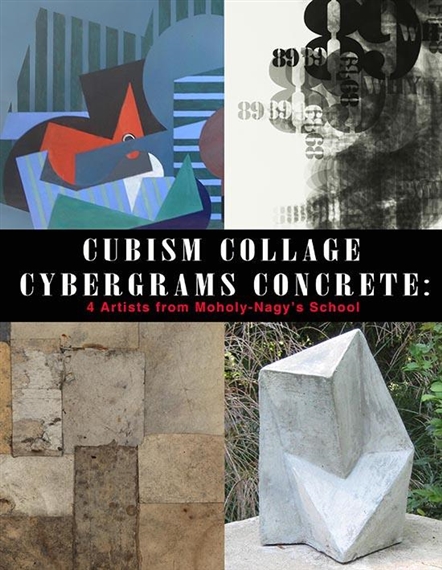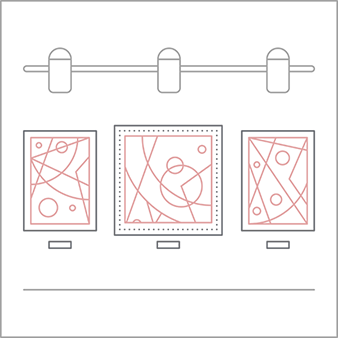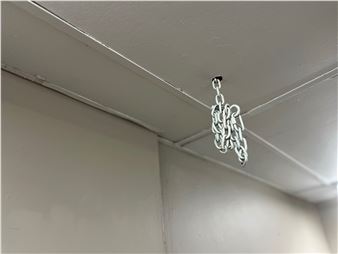Cubism Collage Cybergrams Concrete: 4 Artists from Moholy-NagyвҖҷs School
The Ukrainian Institute of Modern Art is pleased to present the museumвҖҷs second collaboration with the Bauhaus Chicago Foundation, вҖңCUBISM COLLAGE CYBERGRAMS CONCRETE: 4 Artists from Moholy-NagyвҖҷs School.вҖқ This exhibition, curated by T. Paul Young, is rooted in the founding of the New Bauhaus which formally opened its doors in 1937 at the renovated Marshall Field mansion on the near south side of Chicago. This new school, directed by former Bauhaus Master LГЎszlГі Moholy-Nagy, began a powerful and dynamic new chapter within ChicagoвҖҷs art, design and educational community. The four gifted artists exhibited here, Alexander Corazzo, Gretchen Schoeninger Corazzo, Robert Nickle and Tadao Takano, are among many from Moholy-NagyвҖҷs school whose work has received only rare exposure to a broad public audience.
Born in France, Alexander Corazzo attended the New Bauhaus in its inaugural year (1937-38). He spent a decade painting and then began studying architecture in 1943 with Mies van der Rohe, working in his office, then continuing his practice of architecture. In this exhibition, Corazzo is represented by his Cubist paintings created 1932-42; the structural aesthetic of hard edges and flat planes of color in his works on canvas foreshadow CorazzoвҖҷs later career of building actual structures in the landscape.
Gretchen Schoeninger Corazzo, too, started at the New Bauhaus that first year, studying with Ukrainian-born artist Alexander Archipenko, whose influence is apparent in her plaster and cast concrete works on display here. Schoeninger CorazzoвҖҷs very long career (she was still working steadily last year at age 102) is marked with wide-ranging material experimentation, including printmaking, weaving, collages and вҖңpaintingsвҖқ made entirely from seeds, also included in this exhibition.
Like Schoeninger Corazzo, Robert Nickle also used non-art materials to create his multimedia collages, which he started making even before attending Moholy-NagyвҖҷs Institute of Design (a later iteration of the New Bauhaus). For Nickle, (who was also a graphic designer and influential teacher at the University of Illinois in Chicago), the scraps and detritus he found in the street became surrogates for brushstrokes, arranged in abstracted compositions made of real life objects.
Tadao Takano, also a beloved teacher at UIC, began making repeated, machine-aided photographic works in the early 1980s and shortly after developed an entirely new medium he called вҖңcybergrams,вҖқ which he created using an IBM computer and robotic machine. TakanoвҖҷs innovative cybergrams, a selection of which is on display here, are the result of a laborious dance of pinpointed light on photosensitive paper.

The Ukrainian Institute of Modern Art is pleased to present the museumвҖҷs second collaboration with the Bauhaus Chicago Foundation, вҖңCUBISM COLLAGE CYBERGRAMS CONCRETE: 4 Artists from Moholy-NagyвҖҷs School.вҖқ This exhibition, curated by T. Paul Young, is rooted in the founding of the New Bauhaus which formally opened its doors in 1937 at the renovated Marshall Field mansion on the near south side of Chicago. This new school, directed by former Bauhaus Master LГЎszlГі Moholy-Nagy, began a powerful and dynamic new chapter within ChicagoвҖҷs art, design and educational community. The four gifted artists exhibited here, Alexander Corazzo, Gretchen Schoeninger Corazzo, Robert Nickle and Tadao Takano, are among many from Moholy-NagyвҖҷs school whose work has received only rare exposure to a broad public audience.
Born in France, Alexander Corazzo attended the New Bauhaus in its inaugural year (1937-38). He spent a decade painting and then began studying architecture in 1943 with Mies van der Rohe, working in his office, then continuing his practice of architecture. In this exhibition, Corazzo is represented by his Cubist paintings created 1932-42; the structural aesthetic of hard edges and flat planes of color in his works on canvas foreshadow CorazzoвҖҷs later career of building actual structures in the landscape.
Gretchen Schoeninger Corazzo, too, started at the New Bauhaus that first year, studying with Ukrainian-born artist Alexander Archipenko, whose influence is apparent in her plaster and cast concrete works on display here. Schoeninger CorazzoвҖҷs very long career (she was still working steadily last year at age 102) is marked with wide-ranging material experimentation, including printmaking, weaving, collages and вҖңpaintingsвҖқ made entirely from seeds, also included in this exhibition.
Like Schoeninger Corazzo, Robert Nickle also used non-art materials to create his multimedia collages, which he started making even before attending Moholy-NagyвҖҷs Institute of Design (a later iteration of the New Bauhaus). For Nickle, (who was also a graphic designer and influential teacher at the University of Illinois in Chicago), the scraps and detritus he found in the street became surrogates for brushstrokes, arranged in abstracted compositions made of real life objects.
Tadao Takano, also a beloved teacher at UIC, began making repeated, machine-aided photographic works in the early 1980s and shortly after developed an entirely new medium he called вҖңcybergrams,вҖқ which he created using an IBM computer and robotic machine. TakanoвҖҷs innovative cybergrams, a selection of which is on display here, are the result of a laborious dance of pinpointed light on photosensitive paper.

 ARTISTS
ARTISTS











